27 July, 2001
WebCast and Velocity in ice
Life on ice ... almost
This morning, Greg and I woke up super early to parcticipate in a WebCast
conference. While I am not certain if the "web" part worked as well as
intended (remember: we are in the field!), we had a delightful conversation
with some students at Lake Elementary School in Toledo, Ohio.
A couple of questions came up that I wanted to address again (because several
other readers have also asked similar questions):
Is it cold?
"Cold" and "hot" are relative terms. I am extremely hot compared to an ice
cube, but extremely cold compared to the sun.
Compared to Columbus, my time at the Matanuska has been "cold" to "slightly
warm". In the mornings, it is usually cloudy, cool and humid, making me feel
very chilly. If the sun comes out and the wind is pretty calm or if we are
doing something active, it can feel quite warm (t-shirt and shorts). Most
times, I only wear t-shirt and shorts for a brief while before the wind picks
up again and cools us right down.
Temperatures during the day range from 50 to high 60 degrees F. Nighttime
temperatures fall to high 40 or low 50 degrees F.
How do you stay warm?
Lots of different layers of clothes!
Each layer of clothing acts as another layer of insulation between our body
heat and the cold. Most times, the clothing I brought does a pretty good job
keeping me warm (but there have certainly been times when I have wished I had
more layers!)
See my usual morning dress up in the picture below.
How do crevasses form?
Glaciers are giant slabs of ice (sometimes miles long) that are getting
pulled slowly downhill by gravity. As the block of ice travels over the
ground, it interacts with the ground at its sides and underneath it, and may
also flow slowly internally (a bit like a slowed down lava flow).
When the ice has to travel uphill, a small "traffic jam" is caused (ice
doesn't like to go up hill). As pressure builds, the ice cracks. Since it
is getting pushed from behind, the only way for the cracks to open (at the
top of the ice) are parallel to the ice flow.
When the ice passes over the top of a hill, the ice on top is "stretched";
the ice on the surface cracks and creates crevasses perpendicular to the
direction of ice flow.
At today's site, the crevasses formed in long lines from one side of the
glacier to the other. What do you think is happening at the ground level
underneath the glacier?
More news: tomorrow Chris Donovan (a TEA who just finished her research in
the tundra) will be coming down for a brief visit... Most excellent!
Science at work
Just when you thought it was over... velocity is back.
I reported yesterday that the velocity of seismic waves in ice is about 3,800
m/s. This is the velocity at the surface of the ice. The situation
gets a bit more complicated (and is much cooler!)
Snow falls and begins to get buried. As it is buried, pressure builds,
converting snow to firn (granulated snow, consistency of sand). As it
undergoes more burial, the firn begins to compress and begins to transform
into ice. The more it compresses, the more the air squeezes out and the more
the ice grows together. As it grows, the ice crystals tend to grow in an
organized way (with their orientation related to direction of stress they are
experiencing.)
Just as you can swim faster down a stream than across a stream, it turns out
that seismic waves are able to travel faster in certain directions through
the ice. Yesterday, we found that seismic waves at the surface travel a fast
3,800 m/s. Looking at additional data, today we found that the seismic waves
travel 4,300 m/s vertically! Using this information, Greg converted the
seismic data to "distance", and by a similar process, did the same with the
radar data.
Tomorrow morning, the task will be to compare from the two methods! But now,
it's bed time... Whew!
Cheers.
~SM
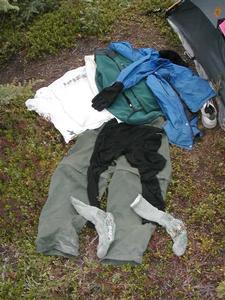
Layered clothing is the key to staying warm. Legs: long underwear, heavy pants (the part below the knees can zip off) Torso and arms: undershirt, long underwear (not shown), t-shirt, long-sleeved shirt, vest, jacket I usually start the day wearing everything and when working in warm places or relaxing in camp end up wearing shorts and a t-shirt. The weather makes dramatic shifts during the course of the day!
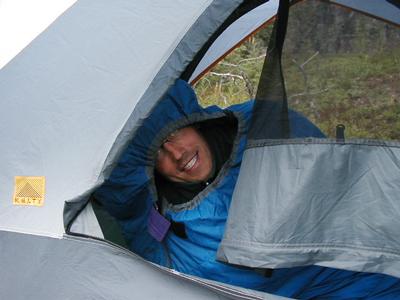
Here I am in the tent, wrapped up in my sleeping bag. Notice the hood (which traps my body's heat that is going to my head)
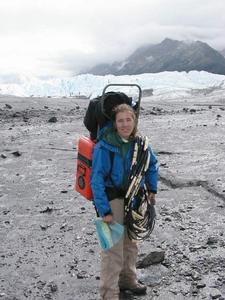
Getting in and out of sites is always a bit of work. The equipment is quite heavy and sometimes we have to walk significant distances to the data collection site.
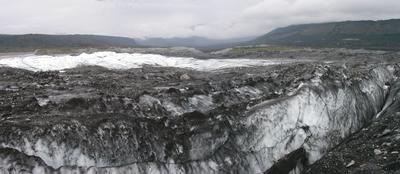
This was our worksite today... Even in the drizzle, it was extraordinary. I took the picture standing on the edge of the series of crevasses that cut the glacier from one side of the glacier all the way to the other (or the medial moraine, anyhow).
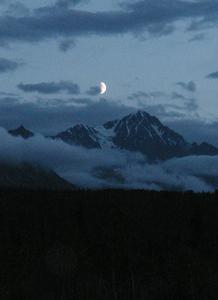
Walking to the lodge last night at 11:45, I was awestruck by the site of the first quarter moon sinking below the mountains. A forest of spruce and a field of brilliant Alaskan fireweed is hidden in the dark foreground. The wind was still and the scene was so peaceful as to be magical.
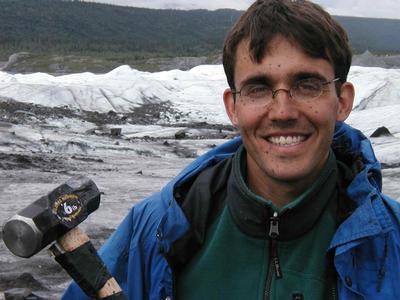
Wielding the seismic hammer of science is a rewarding and messy job. I am not sure the photo will show the mud splattered all over my face, but I am fairly confident the smile can be seen.
Contact the TEA in the field at
.
If you cannot connect through your browser, copy the
TEA's e-mail address in the "To:" line of
your favorite e-mail package.
|
